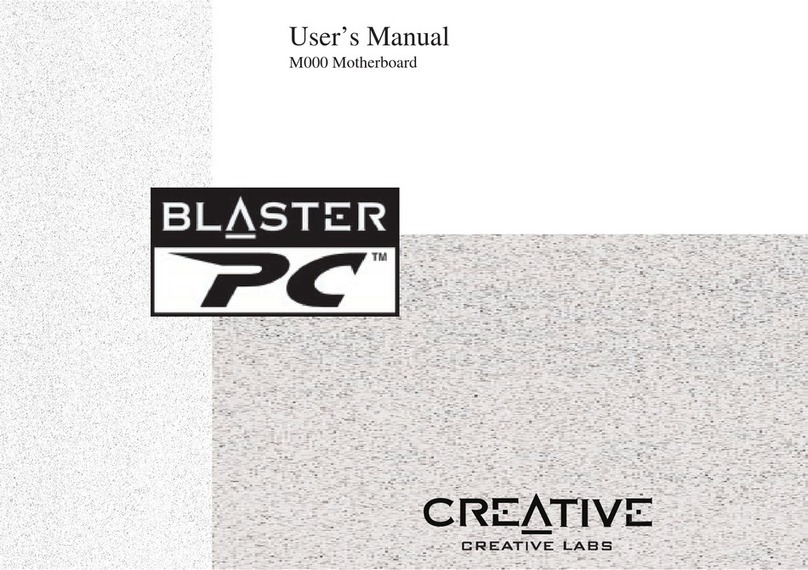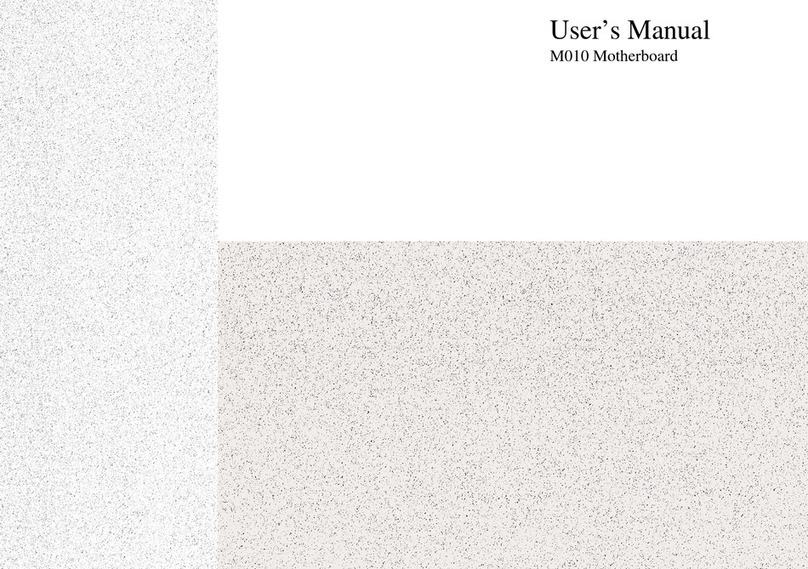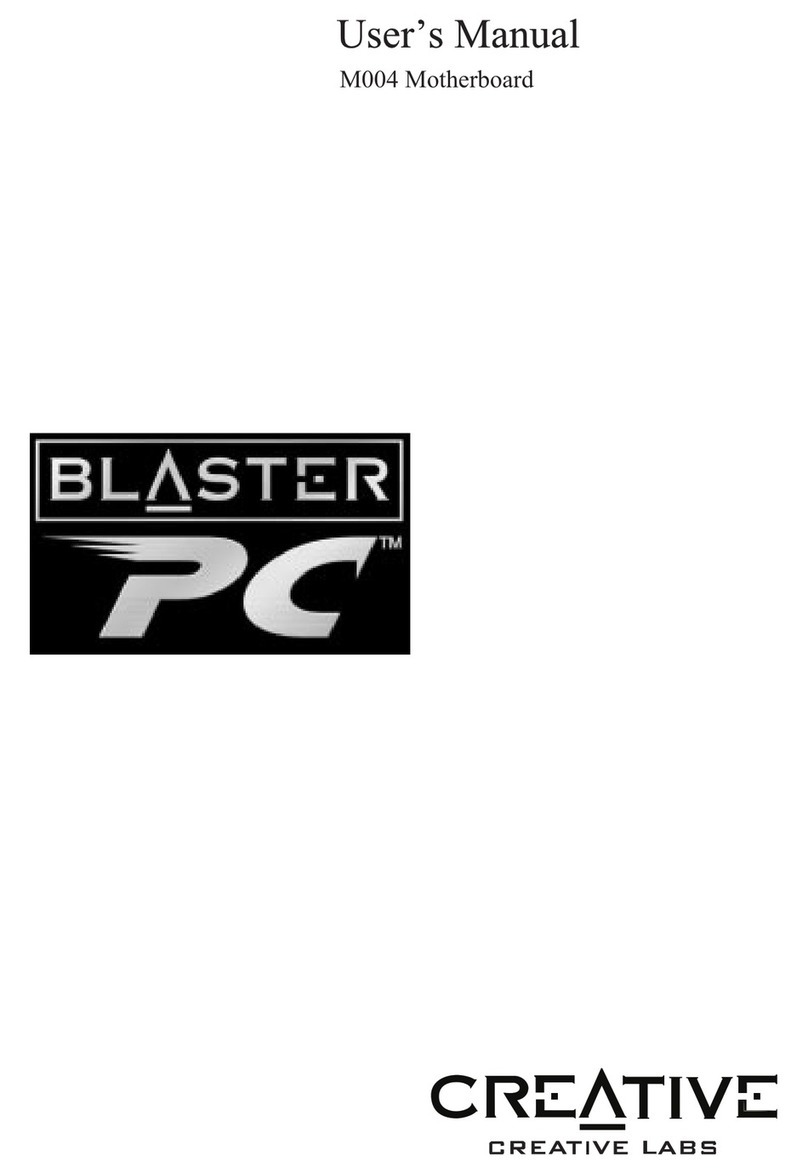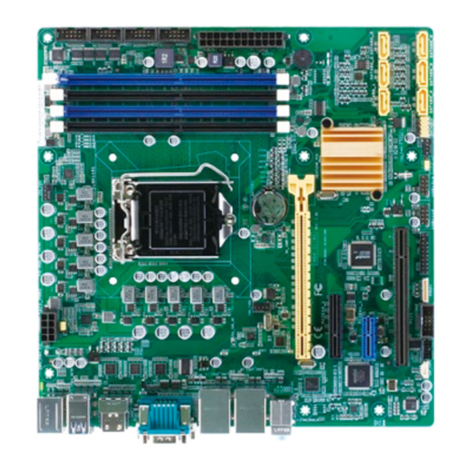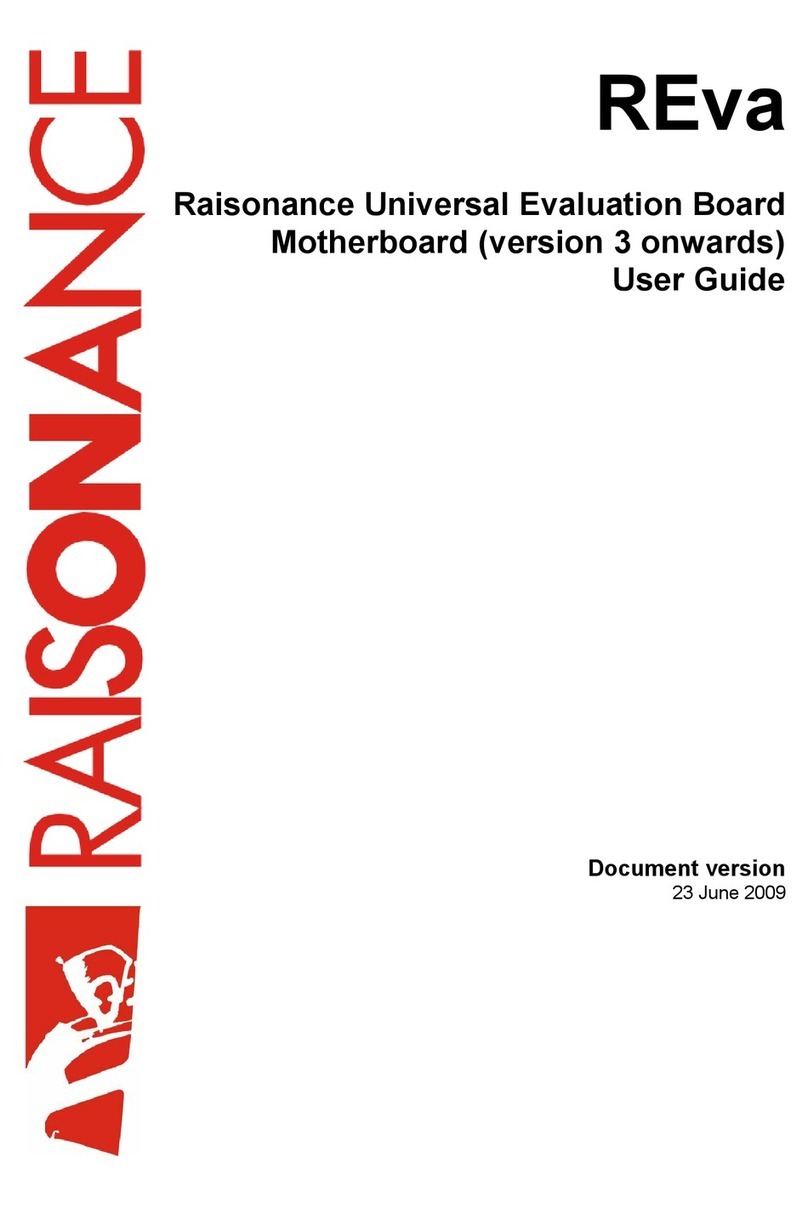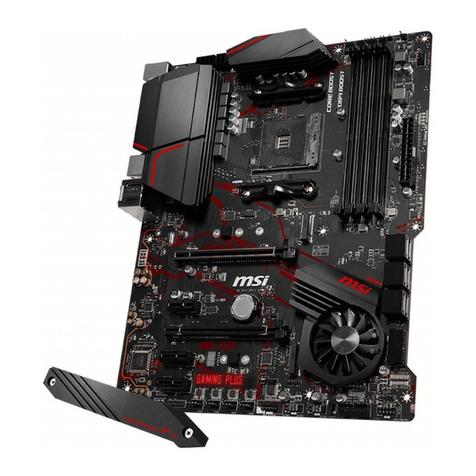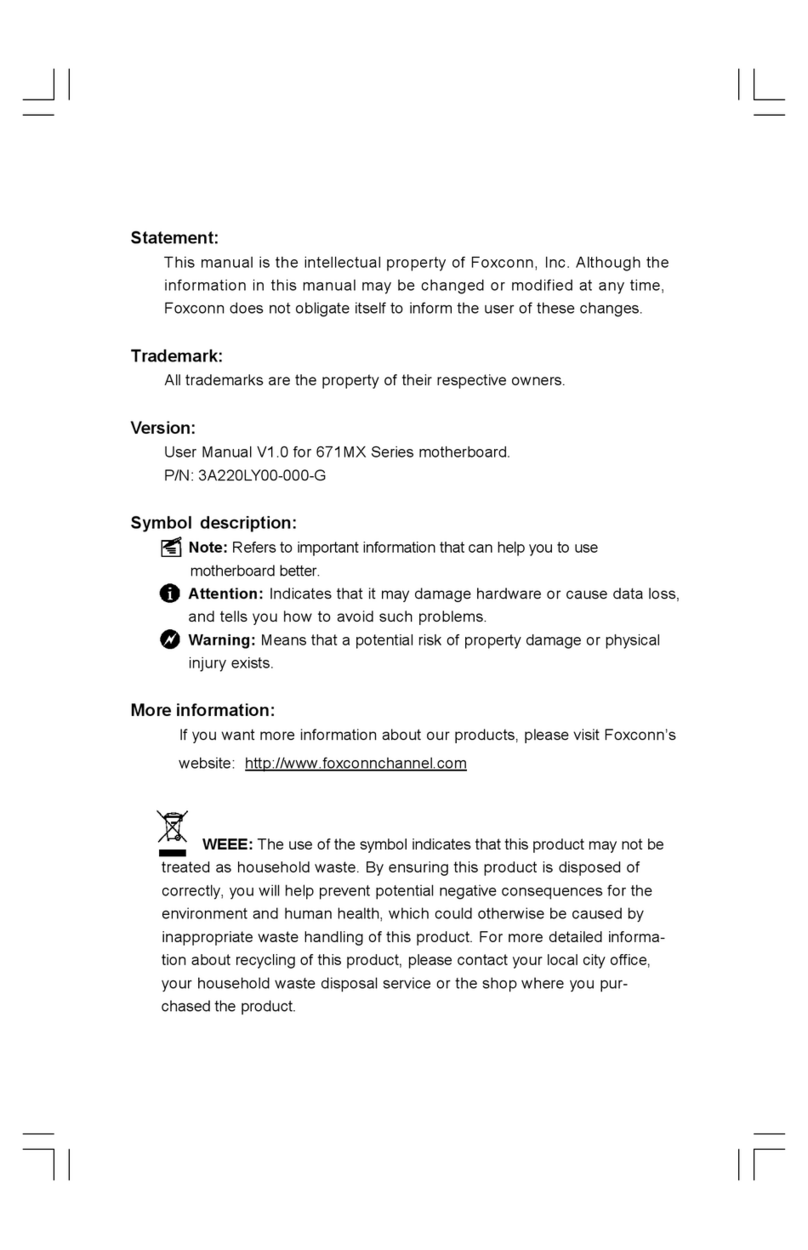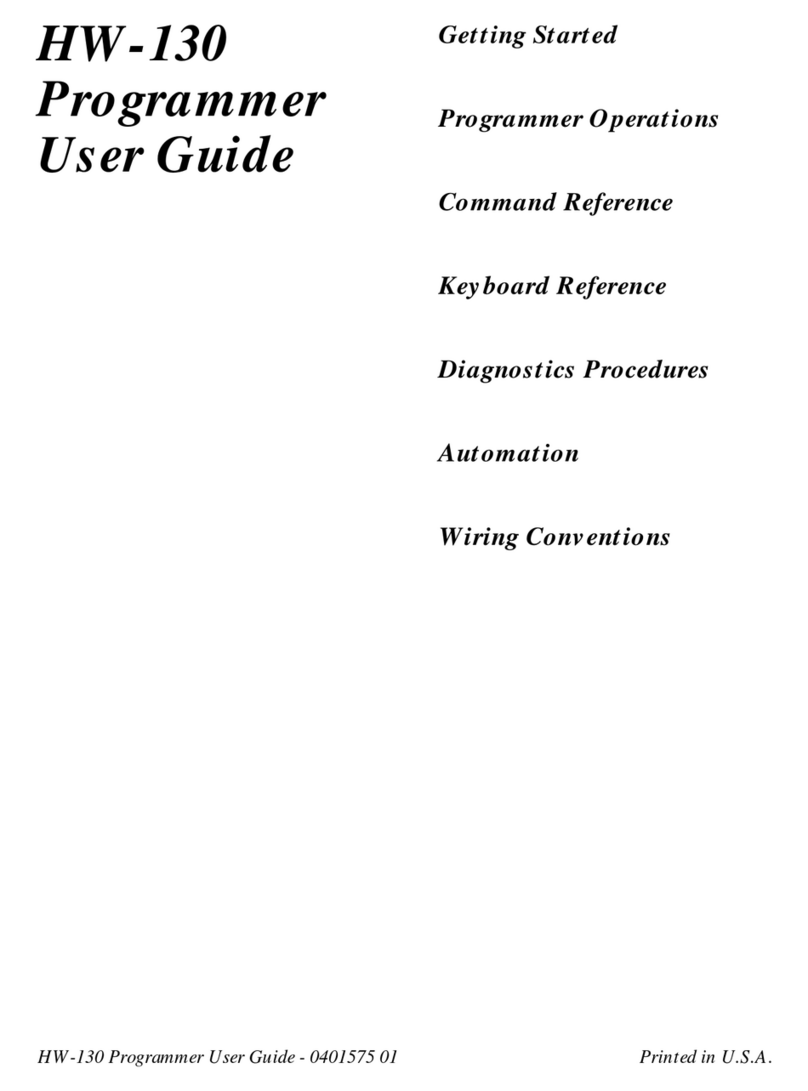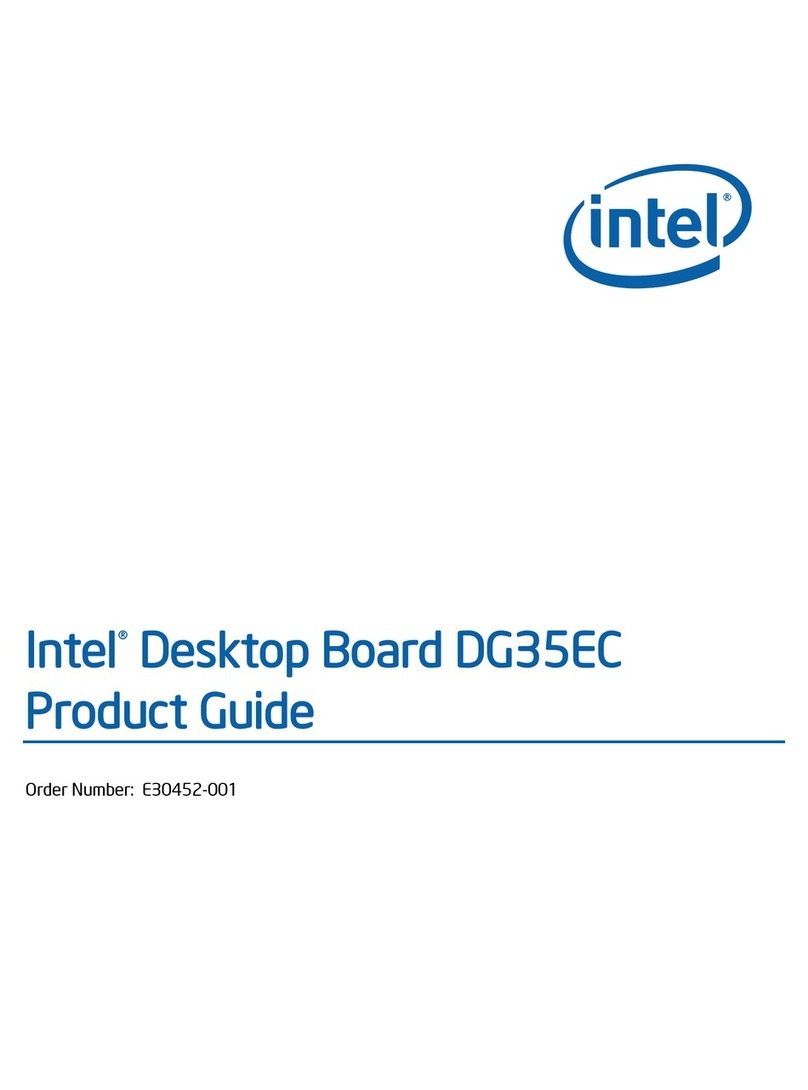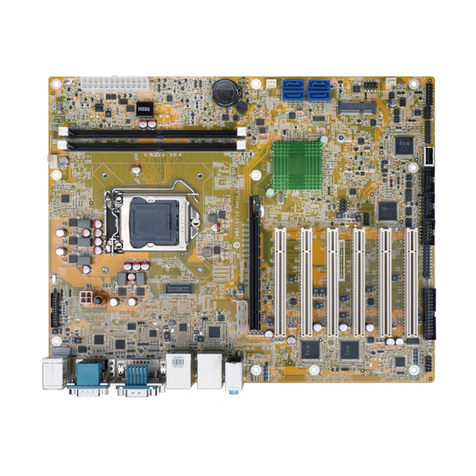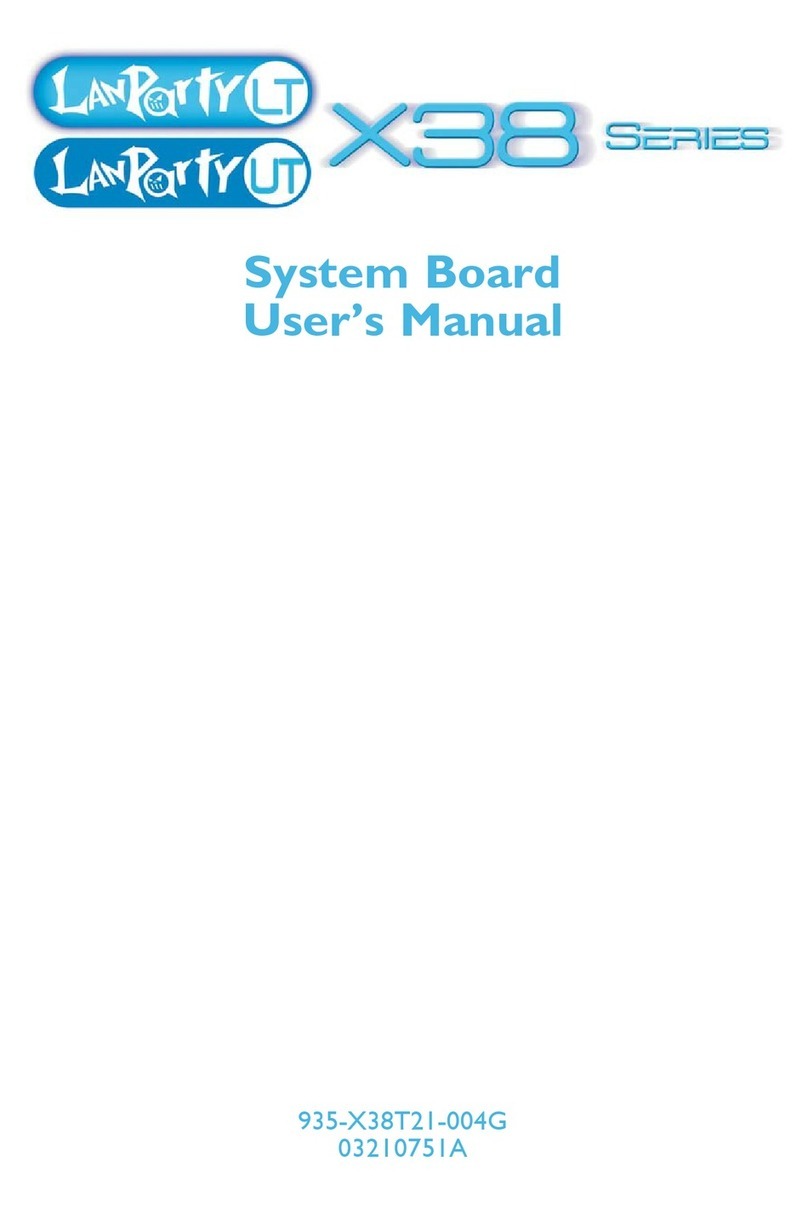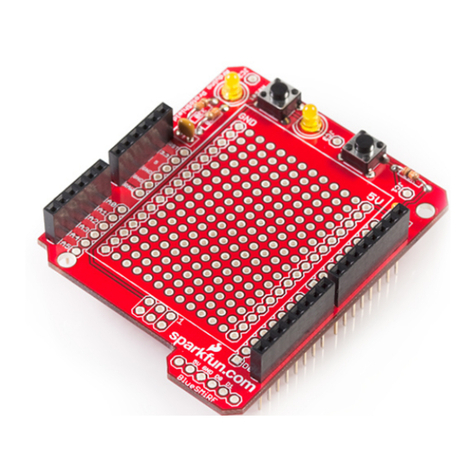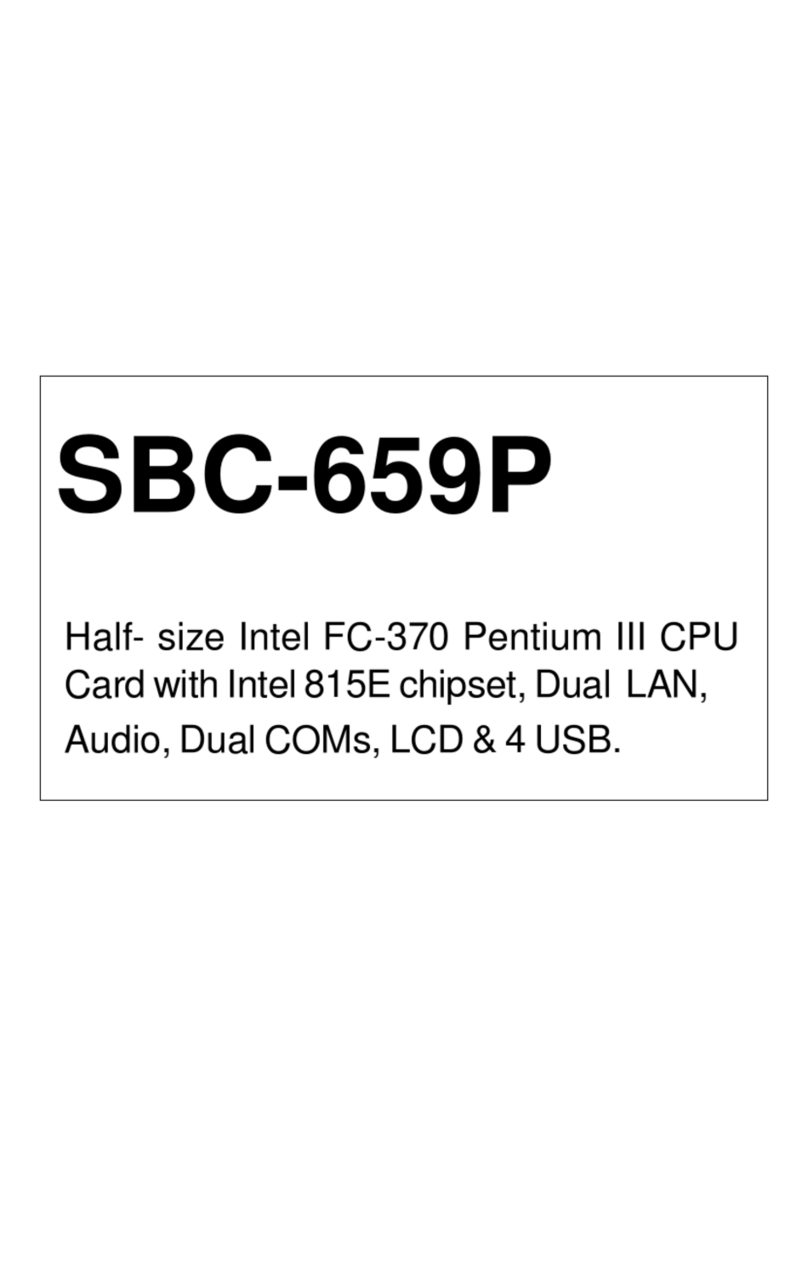Creative M011 User manual

Getting Started
00RWKHUERDUG
Information in this document is subject to change without notice and does not represent a commitment on the part of Creative Technology Ltd. No part of this
manual may be reproduced or transmitted in any form or by any means, electronic or mechanical, including photocopying and recording, for any purpose
without the written permission of Creative Technology Ltd. The software described in this document is furnished under a license agreement and may be used
or copied only in accordance with the terms of the license agreement. It is against the law to copy the software on any other medium except as specifically
allowed in the license agreement. The licensee may make one copy of the software for backup purposes.
Copyright © 2000 by Creative Technology Ltd. All rights reserved.
Version 1.0
June 2000
BlasterPC is a trademark of Creative Technology Ltd.
Intel is a registered trademark of Intel Corporation. Pentium and Celeron are registered trademarks of Intel Corporation. IBM, PC/AT, and PS/2 are registered
trademarks of International Business Machines Corporation. Microsoft, MS-DOS, Windows, and the Windows logo are registered trademarks of Microsoft
Corporation. Microsoft, MS-DOS, and Windows are registered trademarks of Microsoft Corporation.
All other products are trademarks or registered trademarks of their respective owners.
m011.book Page i Monday, July 3, 2000 4:06 PM

Safety & Regulatory Information
The following sections contain notices for various countries:
CAUTION: This device is intended to be installed by the user in a
CSA/TUV/UL certified/listed IBM AT or compatible personal
computers in the manufacturer’s defined operator access area. Check
the equipment operating/installation manual and/or with the
equipment manufacturer to verify/confirm if your equipment is
suitable for user-installed application cards.
ATTENTION: Ce carte est destinée à être installée par l’utilisateur,
dans un ordinateur compatible certifié CSA/TUV/UL ou listé IBM
AT,à l’intérieur de la zone définie par le fabricant. Consulter le mode
d’emploi ou le fabricant de l’appareil pour vérifier ou confirmer si
l’utilisateur peut y installer lui-même des cartes périphériques.
Notice for the USA
FCC Part 15: This equipment has been tested and found to comply
with the limits for a Class B digital device, pursuant to Part 15 of the
FCC Rules. These limits are designed to provide reasonable
protection against harmful interference in a residential installation.
This equipment generates, uses, and can radiate radio frequency
energy and, if not installed and used in accordance with the
instructions, may cause harmful interference to radio
communications. However, this notice is not a guarantee that
interference will not occur in a particular installation. If this
equipment does cause harmful interference to radio or television
reception, which can be determined by turning the equipment off and
on, the user is encouraged to try one or more of the following
measures:
❑Reorient or relocate the receiving antenna.
❑Increase the distance between the equipment and receiver.
❑Connect the equipment to an outlet on a circuit different from
that to which the receiver is connected.
❑Consult the dealer or an experienced radio/TV technician.
Caution
To comply with the limits for the Class B digital device, pursuant to
Part 15 of the FCC Rules, this device must be installed in computer
equipment certified to comply with the Class B limits.
All cables used to connect the computer and peripherals must be
shielded and grounded. Operation with non-certified computers or
non-shielded cables may result in interference to radio or television
reception.
Modifications
Any changes or modifications not expressly approved by the grantee
of this device could void the user’s authority to operate the device.
Notice for Canada
This apparatus complies with the Class “B” limits for radio
interference as specified in the Canadian Department of
Communications Radio Interference Regulations.
Cet appareil estconforme aux normes deCLASSE “B”d’interférence
radio tel que spécifié par le Ministère Canadien des Communications
dans les règlements d’interférence radio.
Compliance
This product conforms to the following Council Directive:
❑Directive 89/336/EEC, 92/31/EEC (EMC)
Declaration of Conformity
According to the FCC96 208 and ET95-19 documents,
Name: Creative Labs Inc.
Address: 1901 McCarthy Boulevard
Milpitas, CA. 95035
United States
Tel: (408) 428-6600
declares under its sole responsibility that the product
Trade Name: Creative Labs
Model Number: M011
has been tested according to the FCC / CISPR22/85
requirementsforClassBdevicesandfoundcompliantwith
the following standards:
EMI/EMC: ANSI C63.4 1992, FCC Part 15 Subpart B
Complies with Canadian ICES-003 Class B.
This device complies with part 15 of the FCC Rules.
Operation is subject to the following two conditions:
1. This device may not cause harmful interference, and
2. Thisdevicemustacceptanyinterferencereceived, including
interference that may cause undesirable operation.
Ce matériel est conforme à la section 15 des régles FCC. Son
Fonctionnement est soumis aux deux conditions suivantes:
1. Le matériel ne peut étre source D’interférences et
2. Doit accepter toutes les interférences reques, Y compris
celles pouvant provoquer un fonctionnement indésirable.
Compliance Manager
Creative Labs, Inc.
14 August, 1998
m011.book Page ii Monday, July 3, 2000 4:06 PM

iii
Contents
Introduction
Document Conventions........................................................................................................ viii
Precautions
Target users...............................................................................................................................ix
Safety Considerations..............................................................................................................ix
Specifications and Layout
Specifications ........................................................................................................................ 1-1
Central Processing Unit................................................................................ 1-1
Chipset .......................................................................................................... 1-1
Clock Generator............................................................................................ 1-2
Main Memory............................................................................................... 1-2
Slots............................................................................................................... 1-2
Onboard IDE ................................................................................................ 1-2
Onboard Peripherals..................................................................................... 1-2
BIOS.............................................................................................................. 1-3
Dimensions................................................................................................... 1-3
Mounting....................................................................................................... 1-3
Motherboard Layout............................................................................................................. 1-3
m011.book Page iii Monday, July 3, 2000 4:06 PM

iv
Installing Upgrades
Installing additional memory................................................................................................2-2
Procedure...................................................................................................................2-3
Information for advanced users................................................................................2-4
Installing expansion cards.....................................................................................................2-5
Procedure...................................................................................................................2-6
Jumpers and Connectors
Central Processing Unit (CPU).............................................................................................3-2
CPU fan connector (CPUFAN) ............................................................................................3-2
Front panel connectors (JFP2) ..............................................................................................3-3
Rear panel connectors............................................................................................................3-5
USB connectors.........................................................................................................3-5
Parallel port connector (LPT1).................................................................................3-6
Serial port connectors (COM A and COM B).........................................................3-7
Mouse and keyboard connectors (JKBMS1).......................................................................3-8
ATX power connector (JWR1).............................................................................................3-9
Remote power and power saving connectors.....................................................................3-11
Remote power On/Off connector (JRMS1)...........................................................3-11
Power saving LED connector (JGL1)....................................................................3-12
CMOS jumper (JBAT1)......................................................................................................3-12
BIOS flash jumper (JFSH1)................................................................................................3-13
USB front connector (USB2)..............................................................................................3-14
System fan connector (SYSFAN).......................................................................................3-16
Wake-up and power saving switch connectors...................................................................3-17
Wake-up on LAN connector (JWOL1)..................................................................3-18
Modem wake-up connector (JMDM1)..................................................................3-18
Power saving switch connector (JGS1)..................................................................3-18
m011.book Page iv Monday, July 3, 2000 4:06 PM

v
Optimum BIOS Settings
Entering and using BIOS...................................................................................................... 4-2
BIOS settings and commands .............................................................................................. 4-4
Standard CMOS Setup............................................................................................. 4-4
BIOS Features Setup ................................................................................................ 4-5
Options.......................................................................................................... 4-6
Chipset Features Setup............................................................................................. 4-8
Options.......................................................................................................... 4-9
Power Management Setup......................................................................................4-11
Options........................................................................................................4-12
PNP/PCI Configuration..........................................................................................4-15
Options........................................................................................................4-16
Integrated Peripherals............................................................................................. 4-17
Options........................................................................................................4-18
Hardware Monitor Setup........................................................................................4-20
Options........................................................................................................4-21
IDE HDD Auto Detection......................................................................................4-22
Supervisor/User Password......................................................................................4-23
Load BIOS Defaults...............................................................................................4-23
Load Setup Defaults ...............................................................................................4-23
m011.book Page v Monday, July 3, 2000 4:06 PM

m011.book Page vi Monday, July 3, 2000 4:06 PM

vii
Introduction
The motherboard is the main circuit board in your computer system. It controls all the parts of
your computer, including the Central Processing Unit (CPU), hard disk memory, disk drives,
power supply, casing controls and various external connectors.
Your BlasterPC is installed with the M011, the latest in Creative’s line of motherboards. A
high-performance model, the M011 is designed for the Intel®Celeron™and Pentium III
Socket-370 processor. The M011 also boasts the latest chipset — the Apollo Pro133A. This
chipset comes with 133 MHz architecture for the CPU and SDRAM. Together, these features
work to give you a speedy, reliable yet inexpensive desktop computer.
Upgrades and additions are easy with the M011. Its three Dual Inline Memory Module (DIMM)
banks can support up to a total of 1.5 GB of SDRAM*, and its five PCI slots give you the choice
of installing additional functions on your BlasterPC. Also equipped with an Accelerated
Graphics Port (AGP) slot, the M011 supports graphics-intensive, 3D applications.
*subject to the availability of 512 MB DIMM modules
m011.book Page vii Monday, July 3, 2000 4:06 PM

viii
Document
Conventions
The following typographical conventions are used throughout this document:
Table i: Document conventions
This Represents
bold Text that must be entered exactly as it appears.
italic Title of a book or a placeholder, which represents the information you
must provide.
UPPERCASE Directory name, file name, or acronym.
The notepad icon indicates information that is of particular importance
and should be considered before continuing.
The alarm clock designates a caution or warning that can help you avoid
situations involving risk.
m011.book Page viii Monday, July 3, 2000 4:06 PM

ix
Precautions
Target users The tasks described in this manual are meant for intermediate and advanced computer users,
who have upgraded, repaired or assembled devices on a computer motherboard.
If you are not familiar with the workings of a motherboard, avoid handling it. You could
damage parts or all of the motherboard, and may need to replace it entirely.
Safety
Considerations
Should you need to open the chassis or computer casing to check or change parts of the
motherboard, be sure to do the following.
❑Read all instructions, especially safety warnings, beforehand.
❑Disconnect the power and monitor cables from the mains.
❑Touch any metal surface on your computer to discharge static electricity from your body.
❑Turn off your computer and all its peripheral devices.
❑Place the chassis on a steady flat surface.
❑Keep any liquids away from the work area.
m011.book Page ix Monday, July 3, 2000 4:06 PM

m011.book Page x Monday, July 3, 2000 4:06 PM

Specifications and Layout 1-1
1
Specifications and Layout
This chapter is organized as follows:
❑Specifications
❑Motherboard Layout.
Specifications
Central Processing Unit ❑Socket-370 Intel®Celeron™or FC-PGA Pentium III processor
❑Supports 233 MHz, 266 MHz, 300 MHz, 333 MHz, 350 MHz, 400 MHz, 450 MHz,
500 MHz, 533 MHz…667 MHz or faster processor
Chipset ❑VIA®VT82C694X chipset
i. 133 MHz FSB
ii. AGP 4x and PCI plus Advanced ECC Memory Controller
iii. Supports PC133 SDRAM, VCM technology
m011.book Page 1 Monday, July 3, 2000 4:06 PM

1-2 Specifications and Layout
❑VIA®VT82C686A chipset
i. Advanced Power Management Features
ii. Integrated Super I/O (FDC, LPT, COM A, COM B and IrDA)
iii. Dual bus Master IDE Ultra DMA33/66
iv. ACPI
Clock Generator ❑Supports 66.6 MHz, 100 MHz and 133 MHz clocks
Main Memory ❑Three 168-pin DIMM slots
❑Supports single-sided and double-sided 3.3V SDRAM DIMM
❑Supports a maximum memory size of 1.5 GB (32M x 8)
❑Supports 1-bit Error Code Correction (ECC)
Slots ❑One Accelerated Graphics Port (AGP) slot
i. AGP specification compliant
ii. AGP 66 MHz 3.3V/1.5V for 2x/4x device support
❑Five 32-bit Master PCI bus slots
❑Supports 3.3V/5V PCI bus interface
Onboard IDE ❑An IDE controller on the VIA®VT82C686A chipset provides the IDE HDD/CD-ROM with
PIO, Bus Master and Ultra DMA 33/66 operation modes
❑Connects up to four IDE devices
Onboard Peripherals ❑Onboard peripherals include:
i. one floppy port supports two Floppy Disk Drives with 360K, 720K, 1.2M, 1.44M and 2.88M
ii. two serial ports (COM A, COM B)
iii. one parallel port supports SPP/EPP/ECP mode
m011.book Page 2 Monday, July 3, 2000 4:06 PM

Specifications and Layout 1-3
iv. two USB ports
v. one IrDA connector
BIOS ❑Provides “Plug and Play” capability which detects peripheral devices and expansion cards
automatically
❑Provides Desktop Management Interface (DMI) which records motherboard specifications
Dimensions ❑ATX Form Factor: 30.5 cm (L) x 19.2 cm (W) x 4 layers PCB
Mounting ❑Six mounting holes
Motherboard
Layout
The following page illustrates the connectors, slots, ports and pins on the M011.
m011.book Page 3 Monday, July 3, 2000 4:06 PM

1-4 Specifications and Layout
Rear panel
connectors.
See page 3-5.
Figure 1-1: M011 motherboard layout
Central Processing
Unit. See page 3-2.
ATX PowerConnector.
See page 3-9.
USB front
connector.
See page
3-14.
Front panel
connectors.
See page 3-3.
Wake-up connectors.
See page 3-18.
CMOS
jumper.
Seepage
3-12.
BIOS Flash
jumper. See
page 3-13.
.
DIMM banks.
See page 2-2.
Expansion
card slots
(PCI). See
page 2-5.
CPU fan
connector.
See page
3-2.
System fan
connector. See
page 3-16.
Remote power
On/Off connector.
See page 3-11.
Power saving LED and
switch connectors. See
page 3-12 and page 3-18.
m011.book Page 4 Monday, July 3, 2000 4:06 PM

Installing Upgrades 2-1
2
Installing Upgrades
The M011 has been pre-assembled and pre-set to provide you with reliable, competent and
optimum performance. To upgrade your system, however, you will need to open up the chassis,
and change or add hardware on your M011.
To help you work safely, this chapter describes the correct procedures for doing the following:
❑Installing additional memory
❑Installing expansion cards.
Working on a motherboard is a
potentially hazardous activity. Be
sure to follow the general safety
guidelines on page ix, and to take
note of any specific warnings.
m011.book Page 1 Monday, July 3, 2000 4:06 PM

2-2 Installing Upgrades
Installing additional
memory
The M011 has three 168-pin unbuffered DIMM banks that support a maximum memory size of
1.5 GB SDRAM*.
One DIMM bank is normally already occupied. This leaves you with two free DIMM banks for
installing additional DIMM modules.
*subject to the availability of 512 MB DIMM modules
Figure 2-1: DIMM banks.
m011.book Page 2 Monday, July 3, 2000 4:06 PM

Installing Upgrades 2-3
Procedure 1. Press the two clips at the ends of the DIMM bank outwards (Figure 2-2).
This is to unlock them.
2. Identify the DRAM and 3.3V notch keys on the DIMM bank.
3. Identify the corresponding notches on the DIMM module. Use only the edges when handling
the module.
4. Position the DIMM module vertically over the DIMM bank, with the module’s notches
facing down. The module will only fit in this direction.
5. Insert the module gently but firmly into the DIMM bank. The side clips snap shut
automatically.
• Only 3.3V SDRAM DIMM is
supported.
• Single- or double-sided
DIMM modules may be used.
Both may also be used
together.
• DIMM banks need not be
occupied in any order. DIMM module
unlocked clips
DIMM bank
Figure 2-2: Installing a DIMM module correctly.
m011.book Page 3 Monday, July 3, 2000 4:06 PM

2-4 Installing Upgrades
Information for
advanced users
The M011 supports the following DRAM addresses and sizes.
Table 2-1: SDRAM Memory Addressing
DRAM
Tech. DRAM
Density
and
Width
DRAM
Addressing Address Size MB/DIMM
Row Column Single-
sided x No. Double-
sided x No.
16M 1M x 16 ASYM 11 8 8 MB x 4 16 MB x 8
2M x 8 ASYM 11 9 16 MB x 8 32 MB x 16
64M 2M x 32 ASYM 11 9 32 MB x 2 64 MB x 4
2M x 32 ASYM 12 8 16 MB x 2 32 MB x 4
4M x 16 ASYM 11 10 32 MB 64 MB
4M x 16 ASYM 13 8 32 MB 64 MB
8M x 8 ASYM 13 9 64 MB 128 MB
64M 2M x 32 ASYM 11 8 16 MB 32 MB
4M x 16 ASYM 12 8 — —
8M x 8 ASYM 12 9 — —
m011.book Page 4 Monday, July 3, 2000 4:06 PM

Installing Upgrades 2-5
Installing expansion
cards
Depending on the configuration of your system, you may have one to four empty PCI slots on
your motherboard. PCI slots are for new expansion cards that you might want to install, for
example, a modem or PC-DVD card.
Figure 2-3: PCI slots.
m011.book Page 5 Monday, July 3, 2000 4:06 PM

2-6 Installing Upgrades
Procedure 1. Unscrew and remove the metal
plate that covers the PCI slot
that you want to use. Keep the
screw and metal plate aside for
use later.
2. Align the bus connector of the
expansion card with the PCI
slot.
3. Press the bus connector firmly
but gently into the slot. Be sure
that the card comes into full
contact with the slot; otherwise,
itwillnot berecognized byyour
system later.
4. Secure the card to the computer
casing with the screw from
Step 1.
Before installing an expansion
card, read the documentation that
comes with it.
Figure 2-4: Inserting an expansion card correctly.
Card is not fully
inserted into PCI slot
PCI slot
m011.book Page 6 Monday, July 3, 2000 4:06 PM
Table of contents
Other Creative Motherboard manuals
Popular Motherboard manuals by other brands
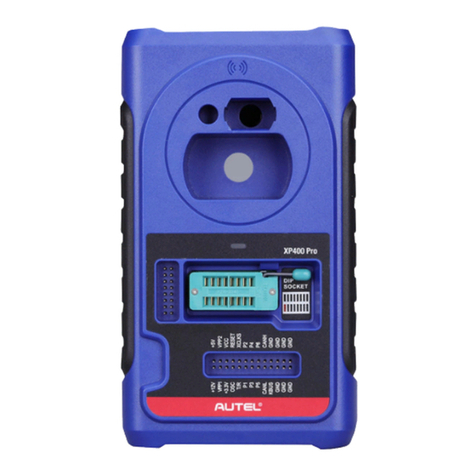
Autel
Autel MaxiProgrammer XP400 Pro manual

PC Partner
PC Partner 35880101 Technical reference booklet
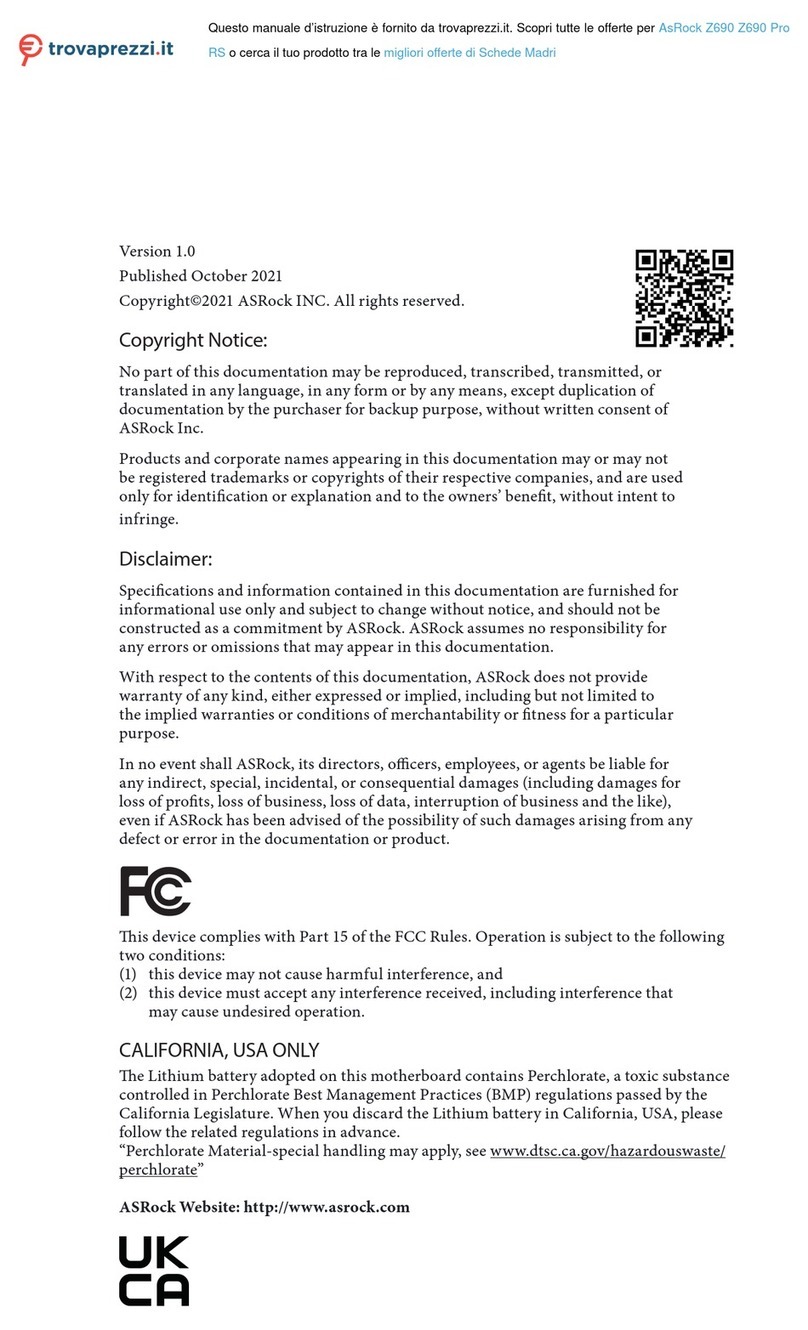
ASROCK
ASROCK Z690 Taichi manual
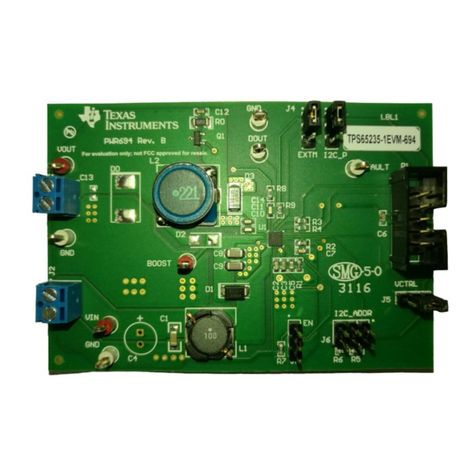
Texas Instruments
Texas Instruments TPS652353 user guide

Asus
Asus P5N-MX - Motherboard - Micro ATX user manual
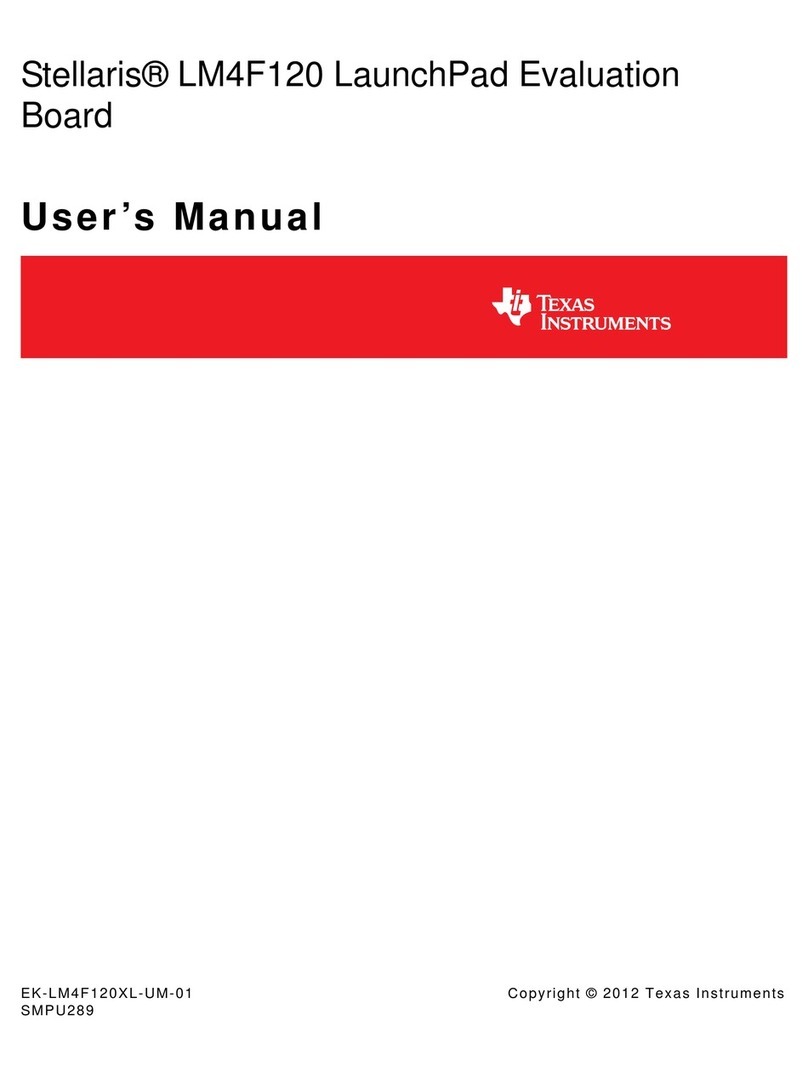
Texas Instruments
Texas Instruments Stellaris LM4F120 LaunchPad user manual


